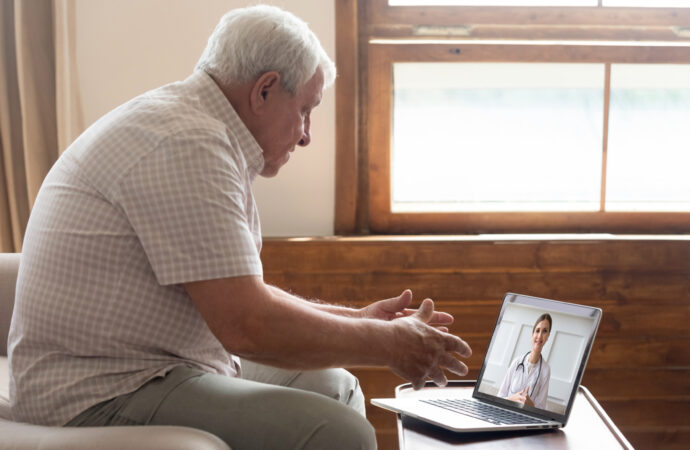Authors: Ravi Datara, Madison Le Galleeb, Sarah Khalilb, Chelsea Pozzebonc
The use of telemedicine in primary care has grown in the wake of the COVID-19 pandemic. It is defined as the integration of the electronic collection and compilation of health data, decision support tools and analytics with the use of audio, video and other technologies to deliver preventive, diagnostic and treatment services that promote patient and population health1. A telehealth platform offers reasonable solutions to issues faced by the Canadian healthcare system such as increasing health demands and home-care requests for an aging population, access to timely health services, and shortage of healthcare professionals in under-serviced communities across the country1. The data suggests that a majority of Canadians are in favour of virtually-delivered care with 63% expressing interest in opportunities for email communication with their providers, and 41% requesting video consultations1.
Access to digital health services helps break down barriers related to financial obstacles, mobility restraints, and other social issues such as agoraphobia or anxiety vis-a-vis in-person interactions with care providers2. Conveniently, patients can carry on with their daytime schedules as per usual while awaiting a call from their provider. In practice, however, setting up a framework within which digital health can operate offers challenges of its own; « e-confidentiality » and confirmation of patient identity, the authenticity of the rapport between patient and physician, lengthened time-to-diagnosis from an initial assessment, and the potential for missed diagnoses. Virtual care may make it more difficult to appreciate a patient’s emotional and physical cues in the office, which can pave the way for misunderstandings and suboptimal patient care.
Telemedicine is one kind of technology that can be used by primary care providers to better health outcomes for their patients. Other kinds of technologies include those that do not involve real-time patient-physician interactions (asynchronous). A stand-out example of this is the health platforms that have enabled patients living with HIV to better their self-management. Systematic reviews have found that the most common barriers that adults face when taking antiretroviral therapy (ART) consistently are forgetfulness (41%), travel (30%), and being busy with other aspects of daily life (29%)3. ART is something that has to be taken on a daily basis for its efficacy. A study looking at how an SMS-based reminder tool affected ART adherence rates in a high-risk HIV-positive population in Canada showed that “adhering to [ART] was significantly improved during the intervention”4. This efficacy of test message-based for promoting adherence in patients living with HIV was also seen in a Cochrane review5.
Other asynchronous health technology interventions have been found useful in improving smoking cessation6, breastfeeding education7, tuberculosis medical adherence8, and in answering adolescents’ questions about sex/drugs/alcohol9. Especially in primary care where topics such as medication adherence and patient education are central, novel health technologies have significant potential to better patient outcomes and quality of life.
At McGill University, there are multiple initiatives through the Department of Family Medicine exploring how to bring primary care to patients battling chronic conditions and barriers in the milieu of the COVID-19 pandemic. For example, Dr. Bertrand Lebouché’s team at the McGill University Health Centre has already rolled out the OPAL health app for patients to track their symptoms, learn about the illness, and manage appointments. A similar initiative is in the process to employ the Facebook-based MARVIN chatbot to help patients living with HIV better manage their health with assistance with ART utilization on a daily basis and while travelling.
In addition, telemedicine can not only maintain and improve treatment, but it also has numerous advantages for the patient-provider relationship. Its remote status increases its accessibility to marginalized peoples, connecting with a sector of the population who are in great need of quality healthcare. For instance, in an exploratory study in Hamilton, Ontario, the use of telemedicine proved effective at decreasing new refugees’ barriers to access to healthcare10. More diversity in the patient population means not only treating those who have previously slipped through the cracks of the system, but also receiving new input towards healthcare and policy change. Similarly, delivering medical expertise directly into people’s homes and smartphones is a powerful tool for fighting medical misinformation. With medical care at the forefront of the minds of a pandemicized population, online misinformation about treatment and doctors has spread increasingly11. Telemedicine can be a means of addressing this, by using the hyperconnectivity of modern society to challenge misinformation through accessible consultation with medical experts.
This being said, it is important for medical professionals not to overstate the benefits of telemedicine while ignoring its drawbacks. Generally speaking, curated telemedicine applications are controlled and operated by private corporations. As a result, an overwhelming profit motive in a burgeoning market forcefully raises concerns of legitimacy, accountability, and security. On September 30, 2020, the US Department of Justice charged 86 criminal defendants for an alleged $4.5 billion in fraudulent healthcare claims12. According to court documents, doctors and nurse practitioners were paid by telemedicine executives to order unnecessary medical equipment, diagnostic testing, genetic testing, and pain medications, following little or no patient interaction. Lack of accountability on this scale not only cost American taxpayers billions but risked irreparably damaging patients’ trust in telemedicine. Even when telemedicine organizations are legitimate, there are concerns over patient data. Patient-provider encounters are routinely conducted on proprietary software like Zoom, which is susceptible to hacks and data breaches13. Neither patients nor practitioners have control of these data and how they are used (or sold) once a meeting ends, which raises legitimate concerns to patients’ rights to privacy in a telemedical context.
Importantly, rather than signal fundamental issues inherent to telemedicine, these limitations highlight the need for secure, professionally-run, and independent telemedicine applications that are responsive to patients, not shareholders. While telemedicine is an opportunity to deliver quality healthcare directly to patients, and to overcome long-entrenched barriers to access, the context with which it is implemented highlights concerns about its safety and long-term applicability in a patient-centered setting. With substantial reform, however, these issues can be solved.
In conclusion, while telemedicine has gained in popularity during the COVID-19 pandemic, it is highly likely that it is here to stay even after the storm has passed. The essential widespread use of various medical electronic platforms has allowed the medical community to appreciate its advantages including easing financial, physical, and social barriers to healthcare access; increasing medication compliance and patient education in the context of eHealth platforms; and improving access to care for marginalized populations. Like any tool in a healthcare system’s arsenal, however, multiple factors need to be highlighted to ensure that the highest quality of online patient care is offered safely and with due diligence. Establishing e-confidentiality, accounting for technical difficulties such as poor network bandwidth, and using independently-run platforms are among the most crucial strategies that can be used to make the best of the new standard of medical practice.
aMcGill University, Medicine Class of 2021(c)
bMcGill University, Medicine Class of 2022(c)
cMcGill University, Medicine Class of 2024(c)
References
- Virtual Care Discussion Paper (PDF)
- Virtual care is here to stay, but major challenges remain
- Patient-Reported Barriers to Adherence to Antiretroviral Therapy: A Systematic Review and Meta-Analysis
- Mobile Text Messaging to Improve Medication Adherence and Viral Load in a Vulnerable Canadian Population Living With Human Immunodeficiency Virus: A Repeated Measures Study
- Mobile phone text messaging for promoting adherence to antiretroviral therapy in patients with HIV infection
- Picture Me Smokefree: A Qualitative Study Using Social Media and Digital Photography to Engage Young Adults in Tobacco Reduction and Cessation
- Feedpal: Understanding Opportunities for Chatbots in Breastfeeding Education of Women in India (PDF)
- Effectiveness of Electronic Reminders to Improve Medication Adherence in Tuberculosis Patients: A Cluster-Randomised Trial
- An artificially intelligent chat agent that answers adolescents’ questions related to sex, drugs, and alcohol: an exploratory study
- Telemedicine: Bridging the Gap between Refugee Health and Health Services Accessibility in Hamilton, Ontario PDF)
- Impact of Rumors and Misinformation on COVID-19 in Social Media
- DOJ charges 86 defendants with $4.5 billion in telehealth fraud
- Over 500,000 Zoom accounts sold on hacker forums, the dark web










